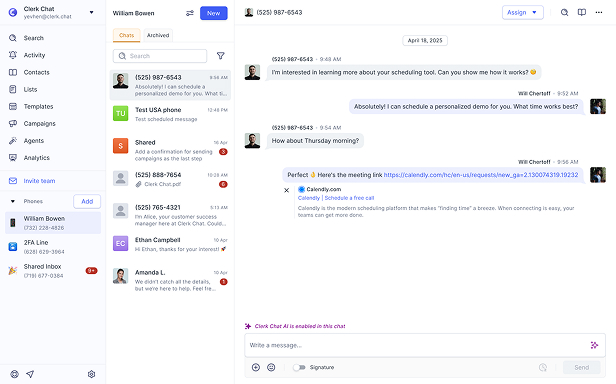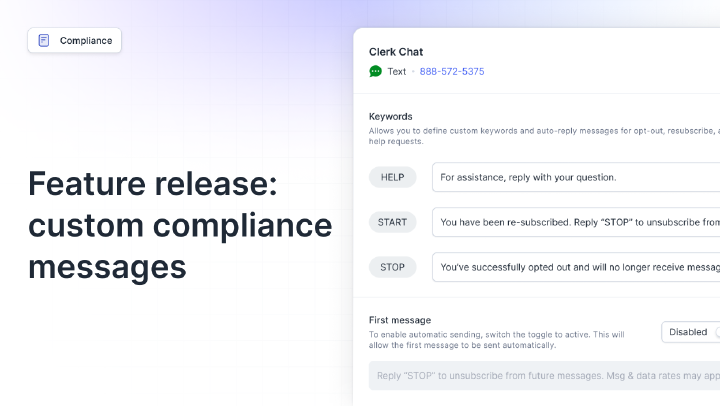SMS Broadcast
[ˌɛsˌɛmˈɛs ˈbrɔːdˌkæst]An SMS broadcast is a method of sending a single text message to a large group of recipients at once. It’s often used for marketing, alerts, or important updates and works best when recipients have opted in to receive such messages.
Why SMS broadcast matters
SMS broadcast helps businesses reach hundreds or thousands of customers instantly, whether it’s to announce a sale, send a weather-related closure, or deliver an appointment reminder. Unlike email or social media, texts are almost always read - usually within minutes - making broadcasts an incredibly effective communication tool.
For time-sensitive or high-priority messages, SMS broadcast delivers unmatched visibility. Retailers can use it for limited-time offers, schools for urgent announcements, and healthcare providers for last-minute appointment openings. Because messages are direct and opt-in-based, they often receive higher engagement and response rates than other channels.
Platforms like Clerk Chat make it easier to manage broadcasts responsibly - ensuring compliance, personalizing messages, and tracking performance metrics like delivery rate and opt-outs.
How SMS broadcast works
Here’s how a typical SMS broadcast is created and delivered:
- Upload or build a contact list - Import contacts or sync from your CRM or communication tools.
- Segment the audience (optional) - Group contacts by behavior, preferences, or tags.
- Create your message - Write the message using text, variables (e.g., first name), and include an opt-out line.
- Schedule or send - Choose whether to send immediately or at a scheduled time for best engagement.
- Review analytics - Track delivery, responses, and unsubscribes to optimize future broadcasts.
Broadcasts are often delivered over 10DLC or short code channels for reliability. Clerk Chat handles throttling, carrier compliance, and deliverability optimization in the background.
Best practices with SMS broadcast
Get clear opt-in from recipients - Only message users who have explicitly agreed to receive texts.
Personalize messages where possible - Use name or location fields to make messages feel relevant.
Send at the right time - Avoid early mornings, late nights, or holidays unless critical.
Keep it short and clear - Focus on one message per broadcast with a clear call-to-action.
Include opt-out instructions - Always let recipients unsubscribe easily (e.g., “Reply STOP to opt out”).
Segment audiences - Improve relevance by grouping contacts based on interests or behavior.
Test and measure - A/B test message copy or send times, and use analytics to improve results.
Real world examples
Common misconceptions
Not true - broadcasts are opt-in by default. Recipients must give permission before receiving texts.
Businesses should use registered 10DLC numbers or short codes to ensure deliverability and compliance.
Small businesses use broadcasts effectively for updates, offers, and customer alerts - often with better engagement than email.
Many broadcasts are used for time-sensitive alerts, reminders, surveys, and internal communications.
Related terms
In this article:
Ready to use your business number for text messaging?
Thousands of businesses are already experiencing the power of conversational messaging through SMS. Join us. Free trial and paid tiers available.
Get StartedFAQ
Have questions? We've got answers.
Find what you need quickly and clearly with our most frequently asked questions.
An SMS broadcast is a one-to-many message sent to a list of contacts. It's commonly used for alerts, announcements, promotions, or reminders where the same message needs to reach multiple people at once.
Clerk Chat lets you create contact lists, write a message, personalize with variables, and send instantly or schedule for later. You can also review delivery analytics and opt-out trends.
Each text in a broadcast counts individually, so large sends may cost more. However, the efficiency of reaching many customers at once often results in a much better ROI.
SMS campaigns are usually strategic, multi-message initiatives. Broadcasts are typically one-off messages, though they can be part of a campaign if scheduled and tracked accordingly.
Yes. You must obtain prior opt-in from recipients, provide opt-out instructions, and follow carrier regulations. Clerk Chat helps automate these compliance steps for all broadcasts.
Keep messages short, send at optimal times, personalize where possible, and always monitor opt-out rates. A/B testing different versions can also help improve engagement.




